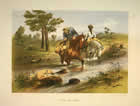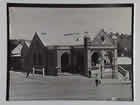Post offices were important institutions on the goldfields. Letters provided news ‘from home’, and information from family, friends or other contacts in Melbourne or on other diggings. If the recipient lived at a fixed address they could arrange for the post office to have it delivered. If this was not the case, then a post office would be given as the address and the recipient would pick up the mail themselves. Post offices were thus responsible not only for sorting mail, but for collection or distribution as well.
By 1856 only 11 post offices were run by the state government, although many others were operated privately. Melbourne, Geelong, Ballarat, Sandhurst (Bendigo) Castlemaine, Belfast, Creswicks Creek, Portland, Beechworth, Warrnambool and Williamstown were all serviced by government-run post offices. The single government post office in Melbourne had difficulty coping with the increase in patron numbers the gold rushes bought. Those wishing to post or collect letters were forced to wait in long queues, with some waiting more than an hour to reach the clerk’s counter. One plaintiff complained of a ‘letter trap’, convinced that the shortage of staff at the beleaguered Melbourne Post Office was responsible for his letters taking months to reach him.
For those living on the goldfields the inevitable wait for mail was hugely increased by the length of time it took to travel from Melbourne to the diggings. Poor roads made transport of all types difficult and the mail was no exception. It wasn’t until Cobb & Co began a run between Bendigo and Melbourne in 1854 that the delivery of mail began to improve. In 1856 monthly delivery of sea mail (via steamship) further added to the improvement of the postal service.
Those post offices not run by the government operated as private businesses. It is extremely difficult to know just how many private post offices operated on the goldfields and elsewhere (very little research has been completed on this topic), but there must have been rather more than the 11 government post offices. One such post office opened at Fryers Creek in March 1852. According to an advertisement placed in the Argus it was situated ‘at the Spring, near the sheep station hut’. It’s unlikely that the post office was little more than a tent or wood and bark construction.
Running a post office was often a form of additional business and was generally partnered with storekeeping. Those who ran the post office did not receive any direct form of remuneration for their efforts, although they did receive a commission for the stamps they sold.
The establishment of a post office, such as the one at Fryers Creek, made life more civilised for miners and others on the diggings. Firstly, it meant that people did not have to travel for miles in order to post or collect their mail. Secondly, it reduced the time it took mail to reach recipients. The establishment of a post office at Fryers Creek in 1852 meant that letters directed to Fryers Creek or Upper Loddon diggings were sent direct from Kyneton, rather than ‘going round by Forest Creek’.
While the Melbourne Post Office, by virtue of its long establishment (1835) was a stone construction, regional post offices were often far less substantial. Until the wealth of the gold rushes began to filter through, even government-run post offices were often canvas or wood constructions. The wealth generated by the gold rushes generated a public building boom throughout the late 1850s and 1860s and post offices were no exception. Beechworth’s first purpose built post office was built in 1858, and residents were purportedly disappointed that it was only a single storey construction. The following year they contributed to a fund to pay for a clock imported by a local jeweler. The clock cost ₤150 and was duly added to the modest post office building. The addition of the clock and the townsfolk’s disappointment at their less than grand post office illustrates the enormous pride that residents often took in public buildings and institutions. Many of the first regional government post offices constructed during the late 1850s and throughout the 1860s are still standing (albeit with some alterations and additions) and remain a physical embodiment of the enormous wealth the gold rushes bought to Victoria.




